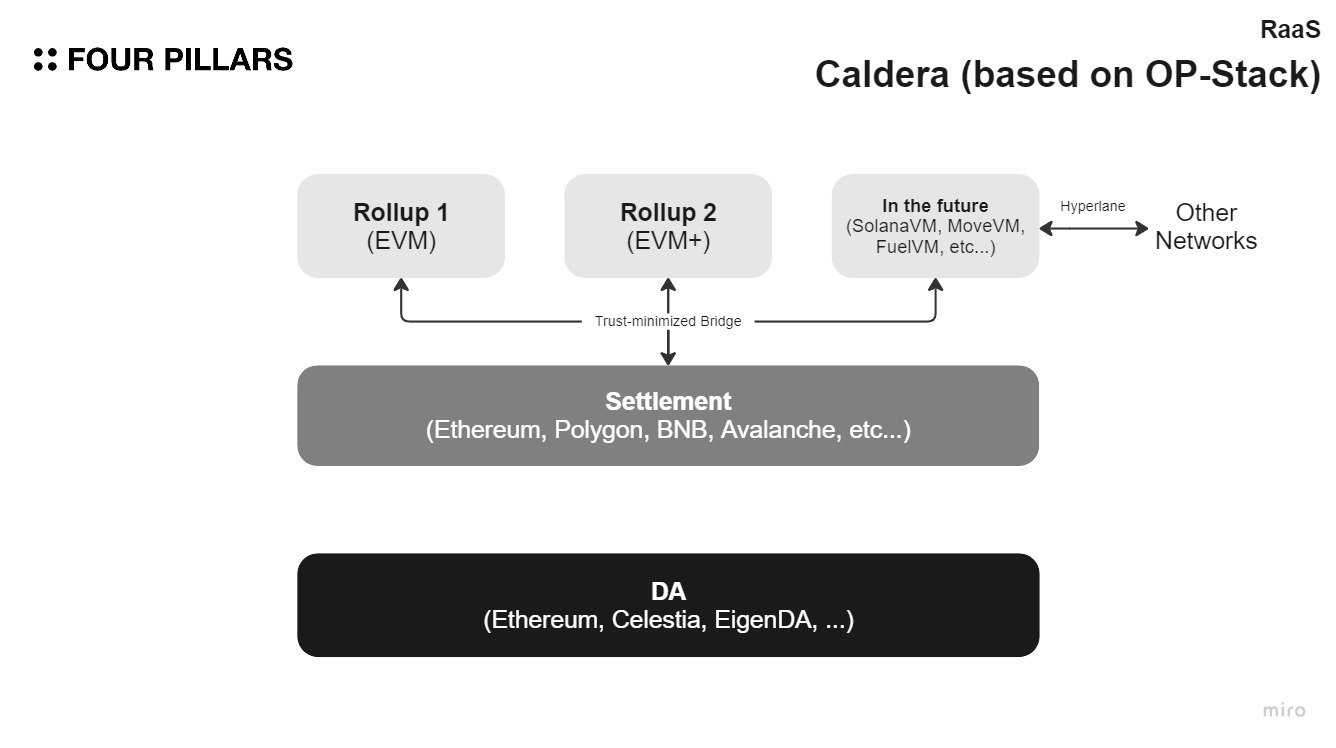Caldera
Key Takeaways
- Caldera is based on the OP Stack, enabling anyone to launch an optimistic rollup without code.
- From a modular blockchain perspective, Caldera Chains have a high degree of freedom, allowing not only the choice of various execution environments, settlement layers, and DA layers but also various customizations within the network.
1. Overview

Caldera is a service that allows the launch of customizable, app-specific rollups without code. Caldera currently supports optimistic rollups, and the rollup networks launched through this are referred to as "Caldera Chains." Caldera not only facilitates the launch of rollups, but also offers various infrastructure services such as Block Explorers, Testnet Faucets, Bridges, NFT Marketplace, Oracles, and more.
2. Execution
Because Caldera is based on the OP Stack to launch optimistic rollups, it supports the EVM as the computational environment. Given its high EVM compatibility at the OP Stack level, it has the advantage of fully utilizing a multitude of Ethereum-based developer tools. In the future, not only EVM but also EVM-Plus, which allows for modifications to the EVM, and other execution environments like SolanaVM, MoveVM, and FuelVM will be supported.
3. Settlement
Caldera Chains can use any EVM-compatible network as a settlement layer. While most Caldera Chains use Ethereum or Polygon as their settlement layer, it also supports a variety of networks such as BNB Chain, Avalanche, Evmos, Aurora, etc.
As Caldera Chains are optimistic rollups, they submit fraud proofs to the settlement layer to validate the transactions. Because it uses the OP Stack directly, the challenge process is the same, and if the challenge is successful, the commitment is excluded from the StateCommitmentChain and replaced with a new one.
While Caldera Chains ultimately follow the finality of the DA layer, they can choose various finality options depending on the purpose of the rollup network before that. Slow finality can be granted for high-value transactions handling large amounts of money, whereas fast finality can be granted for other transactions like micropayments. If the application uses both types, the finality can be set differently depending on the type of transaction.
4. Data Availability
In addition to the option of using the settlement layer as the DA layer, Caldera Chains also allow for the use of data availability-specialized solutions such as EigenDA or Celestia.
5. Interoperability
Caldera essentially provides a trust-minimized bridge with the settlement layer. For communication with other networks, the Hyperlane bridge is introduced, allowing Caldera Chains to communicate through Hyperlane. The Hyperlane bridge between the Goerli Caldera Chain and Polygon Caldera Chain is currently deployed to be used in practice.
6. Customization
Caldera supports a high degree of customization, aiming to deploy app-specific rollups easily.
- Gas Fee: Besides ETH, gas fees can be paid through ERC-20 tokens specified by the operator.
- Revenue Generation: Transaction fees, bridge fees, MEV, etc., can be monetized at the project or DAO level.
- Whitelist: Operators of Caldera Chain can whitelist to allow only specific users to interact with the network.
- Finality: The time it takes for a block to finalize can be determined based on the importance of the transaction.
- Sequencer Locations: For projects where low latency is important, sequencers can be placed in areas where major users are concentrated to provide a higher UX.
- Multi-VM: In the future, in addition to the EVM, options such as the modified EVM called EVM-Plus and SolanaVM, MoveVM, and more will be available.
7. Use Cases
7.1 Manta
Manta Network is the multi-modular ecosystem for ZK applications. One of its products, Manta Pacific, is an L2 network built by Caldera. It utilizes Celestia for its data availability layer.
7.2 Curio
Curio is a studio producing fully on-chain games. On-chain games tend to consume a lot of gas fees and require low latency. By using Caldera, these drawbacks could be addressed.
7.3 Cronos
Cronos is an EVM-compatible network developed by Crypto.com with a diverse ecosystem. Caldera collaborates with Cronos to facilitate the easy deployment of rollup networks based on Cronos.
7.4 LOOT
LOOT, which once gained fame as an NFT with items listed in the text on a black background, is also planning to launch a rollup network through Caldera, paving the way for autonomous worlds.
7.5 Syndr
Syndr Chain is an app-specific L3 on Arbitrum, focusing on the institutional-grade trading platform. The interesting thing is that Caldera not only supports OP-Stack but also Arbitrum Orbit to build L2 networks.
8. Team
- Matt Katz (Founder)
- Alex Gu
- Parker Jou
